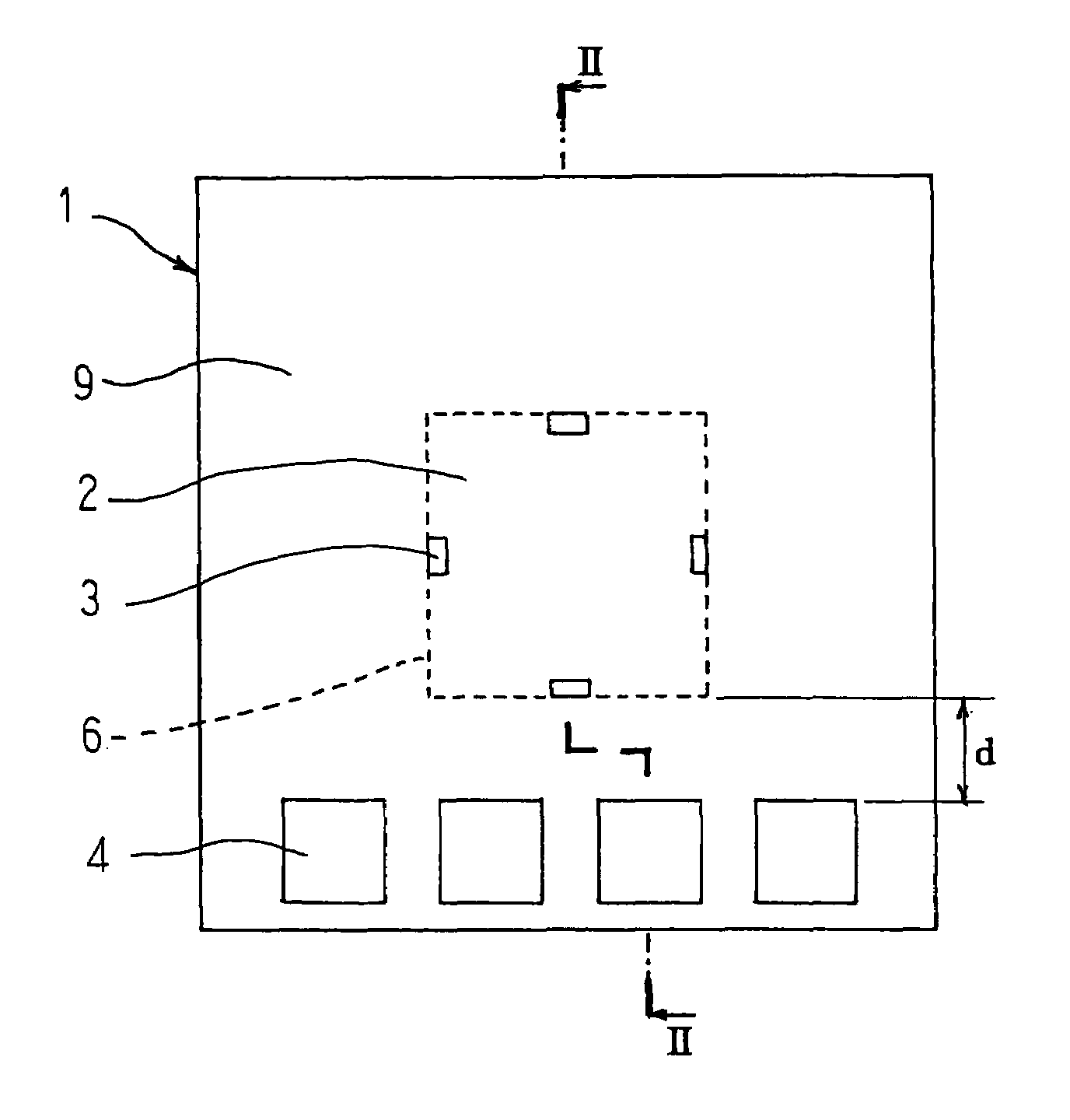Semiconductor strain sensor
a technology of micro-conductor and sensor, which is applied in the direction of fluid pressure measurement, fluid pressure measurement by electric/magnetic elements, instruments, etc., can solve the problems of thermal hysteresis, thermal stress, temperature drift, etc., in the output signals of the sensor, and achieve the effect of suppressing thermal hysteresis of the output voltag
- Summary
- Abstract
- Description
- Claims
- Application Information
AI Technical Summary
Benefits of technology
Problems solved by technology
Method used
Image
Examples
embodiment 1
[0014]FIG. 1 is a plan that schematically shows a configuration of a semiconductor strain sensor according to Embodiment 1 of the present invention, and FIG. 2 is a cross section that is taken along line II-II in FIG. 1 so as to be viewed from the direction of the arrows. A semiconductor strain sensor according to Embodiment 1 is assumed to be for measuring intake air pressure inside an intake manifold of a vehicle engine, and to have a pressure range that is up to approximately 5 atmospheres.
[0015]In FIGS. 1 and 2, an SOI substrate 1 is prepared, for example, by fixing together two silicon substrates by means of an embedded oxide film 10, and polishing the silicon substrate on a front surface to a desired thickness. The SOI substrate 1 includes: a thin, pressure-detecting diaphragm portion 2; and a thick outer frame portion 9 that is formed around the diaphragm portion 2. The diaphragm portion 2 is formed by applying deep reactive ion etching (DRIE) from a rear surface of the SOI s...
embodiment 2
[0029]In Embodiment 2, electrodes 4 are disposed at positions on an outer frame portion 9 that are separated by greater than or equal to 120 μm toward the outer frame portion 9 from a boundary line between a diaphragm portion 2 and the outer frame portion 9.
[0030]Moreover, the rest of this embodiment is configured in a similar manner to Embodiment 1 above.
[0031]In semiconductor strain sensor manufacturing processes, there may be deviations in the processing precision of the diaphragm portion 2 and the electrodes 4. Positions at the boundary line 6 between the diaphragm portion 2 and the outer frame portion 9 in particular deviate easily since the diaphragm portion 2 is formed by etching from the rear surface of the SOI substrate 1 using DRIE.
[0032]Thus, if a lower limit of the distance d between the boundary line 6 between the diaphragm portion 2 and the outer frame portion 9 and the electrodes 4 is set to 100 μm, there is a risk that sensor chips in which the distance d is less tha...
embodiment 3
[0034]In Embodiment 3, thickness of a diaphragm portion 2 is stipulated as less than or equal to 30 μm.
[0035]Moreover, the rest of this embodiment is configured in a similar manner to Embodiment 1 above.
[0036]According to Embodiment 3, because the thickness of the diaphragm portion 2 is stipulated to be less than or equal to 30 μm, the effects of thermal stresses from the electrodes 4 on the piezoresistive elements 3 can be reduced, enabling thermal hysteresis of the output voltage per sensor chip unit to be reliably suppressed to less than or equal to 0.2 percent FS.
[0037]Here, considering sensor characteristics, it is desirable for the thickness of the diaphragm portion 2 to be set to greater than or equal to 1 μm.
[0038]Moreover, in each of the above embodiments, the semiconductor strain sensor is explained as being used in a pressure sensor, but the semiconductor strain sensor is not limited to pressure sensors and may also be used in other physical quantity sensors such as accel...
PUM
 Login to View More
Login to View More Abstract
Description
Claims
Application Information
 Login to View More
Login to View More - R&D
- Intellectual Property
- Life Sciences
- Materials
- Tech Scout
- Unparalleled Data Quality
- Higher Quality Content
- 60% Fewer Hallucinations
Browse by: Latest US Patents, China's latest patents, Technical Efficacy Thesaurus, Application Domain, Technology Topic, Popular Technical Reports.
© 2025 PatSnap. All rights reserved.Legal|Privacy policy|Modern Slavery Act Transparency Statement|Sitemap|About US| Contact US: help@patsnap.com



